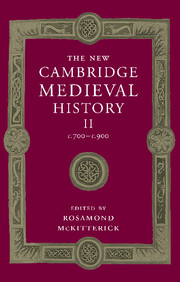Book contents
- Frontmatter
- PART I POLITICAL DEVELOPMENT
- PART II GOVERNMENT AND INSTITUTIONS
- PART III CHURCH AND SOCIETY
- PART IV CULTURE AND INTELLECTUAL DEVELOPMENTS
- Conclusion
- Appendix genealogical tables
- List of primary sources
- Bibliography of secondary works arranged by chapter
- Index of manuscripts
- General index
- Frontispiece">
- Plate section
- Map 4 Charlemagne’s Europe and Byzantium, 814
- Map 19 The ecclesiastical provinces of western Europe 700-900
- Map 20 Carolingian schools, scriptoria and literary centres
- Genealogical table X: Wessex
Conclusion
Published online by Cambridge University Press: 28 March 2008
- Frontmatter
- PART I POLITICAL DEVELOPMENT
- PART II GOVERNMENT AND INSTITUTIONS
- PART III CHURCH AND SOCIETY
- PART IV CULTURE AND INTELLECTUAL DEVELOPMENTS
- Conclusion
- Appendix genealogical tables
- List of primary sources
- Bibliography of secondary works arranged by chapter
- Index of manuscripts
- General index
- Frontispiece">
- Plate section
- Map 4 Charlemagne’s Europe and Byzantium, 814
- Map 19 The ecclesiastical provinces of western Europe 700-900
- Map 20 Carolingian schools, scriptoria and literary centres
- Genealogical table X: Wessex
Summary
in all the chapters in this volume, far more has been documented than mere change and adjustment. It is not for nothing that recent studies have invoked phrases such as the ’formation of Europe’ in relation to the early middle ages and in particular to the two centuries between 700 and 900, the period examined in such detail in this book. Since the planning got under way in the late 1950s for the splendid Council of Europe exhibition on Charlemagne, mounted at Aachen in 1965, the Carolingian ruler has been the symbol, rightly or wrongly, of European unity and the common cultural heritage of Europe. The Carolingian period and the role of Frankish political expansion and cultural imperialism have taken their place in the historiography of most European countries as an essential phase in those countries’ development. As is clear from the relevant chapters above, some areas, such as Ireland, Scotland, Wales, Bulgaria or Scandinavia, were outside the direct sphere of influence of the Franks, yet cannot be said to be totally unaffected by events within the Frankish world. Peripheral regions, at the. fines imperil, were affected in one way or another. Not one region of the area we now think of as Europe was so self-contained as to remain entirely untouched by events in the Carolingian heartlands, even among those for whom the benefits of Carolingian rule may not have been either welcome or obvious. To this extent, therefore, the Frankish dominance of the historical evidence is not entirely unaccountable.
- Type
- Chapter
- Information
- The New Cambridge Medieval History , pp. 845 - 848Publisher: Cambridge University PressPrint publication year: 1995

